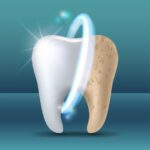Gum recession is the process in which the margin of the gum tissue that surrounds the teeth wears away, or pulls back, exposing more of the tooth, or the tooth’s root. When gum recession occurs, “pockets,” or gaps, form between the teeth and gum line, making it easy for disease-causing bacteria to build up. If left untreated, the supporting tissue and bone structures of the teeth can be severely damaged, and may ultimately result in tooth loss.
Gum recession is a common dental problem. Most people don’t know they have gum recession because it occurs gradually. The first sign of gum recession is usually tooth sensitivity, or you may notice a tooth looks longer than normal. Typically, a notch can be felt near the gum line.
Gum recession is not something you want to ignore. If you think your gums are receding, make an appointment with your dentist. There are treatments that can repair the gum and prevent further damage.
Why Do Gums Recede?
There are a number of factors that can cause your gums to recede, including:
Periodontal diseases. These are bacterial gum infections that destroy gum tissue and supporting bone that hold your teeth in place. Gum disease is the main cause of gum recession.
Your genes. Some people may be more susceptible to gum disease. In fact, studies show that 30% of the population may be predisposed to gum disease, regardless of how well they care for their teeth.
Aggressive tooth brushing. If you brush your teeth too hard or the wrong way, it can cause the enamel on your teeth to wear away and your gums to recede.
Insufficient dental care. Inadequate brushing, flossing, and rinsing with antibacterial mouthwash makes it easy for plaque to turn into calculus (tartar) — a hard substance that builds on and between your teeth and can only be removed by a professional dental cleaning. It can lead to gum recession.
Hormonal changes. Fluctuations in female hormone levels during a woman’s lifetime, such as in puberty, pregnancy, and menopause, can make gums more sensitive and more vulnerable to gum recession.
What Are the Risk Factors?
- Age is a key risk factor for receding gums. Around 88 percent of people older than 65 years have a receding gum in at least one tooth.
- People who smoke and use tobacco products also face an increased risk of receding gums.
- Genetics is another factor, as people who have thin or weak gums can pass these characteristics on via their genes.
- Diabetes can also increase the risk of receding gums.
Symptoms of receding gums
Receding gums can cause teeth to feel sensitive to cold and heat.
Many people with receding gums may have no concerns about them early on and might not be aware that their gums are receding.
However, when people have receding gums, they may experience the following:
- concerns about changing appearance, as the tooth appears longer and the space between teeth increases
- fear of losing teeth
- sensitivity to cold and heat due to exposed tooth roots
Most importantly, receding gums can be a symptom of underlying dental problems, including gum disease, and can increase the risk of tooth decay and tooth loss. They can also lead to bad breath and bleeding gums.
Treatment of receding gums
Most cases of mild gum recession do not need treatment. Dentists may advise on prevention and offer to monitor the gums. Teaching effective but gentle brushing is an effective early intervention.
For people who do need treatment, several options are available:
- Desensitizing agents, varnishes, and dentin bonding agents: These products aim to reduce the sensitivity of the exposed tooth root. Desensitizing agents treat the nerve symptoms and help preserve oral hygiene by easing the brushing of sensitive teeth.
- Composite restoration: A dentist uses tooth-colored composite resins to cover the surface of the root. They can also close the black gaps between teeth.
- Pink porcelain or composite: This material is the same pink color of the gums and can be applied to fill the gaps where the gums have receded.
- Removable gum veneers: These are usually acrylic or silicone, and they artificially replace the large area of missing gum tissue due to recession.
- Orthodontics: These include treatments that slowly move the position of the teeth over a long period. This repositioning can correct the gum margin and make it easier to keep the teeth clean.
- Surgery: A dental surgeon grafts tissue from another site in the mouth and the tissue heals over the gum recession. A person would usually only need this to treat severely receding gums.
Resources:
We love our patients and love to help them form healthy dental life that will last them a lifetime. For more information call us today to answer all of your questions so get an appointment









